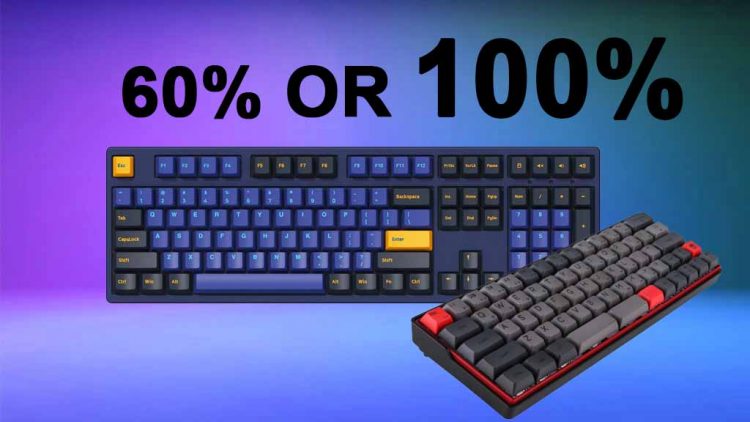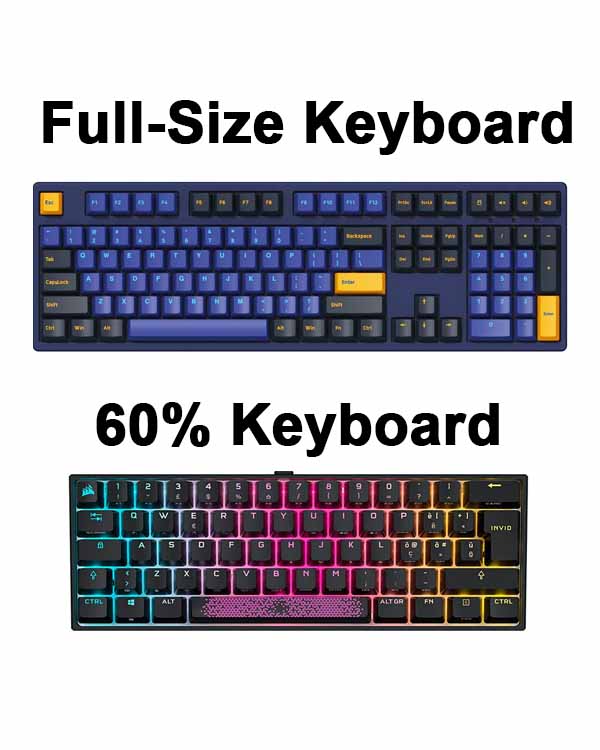Which keyboard layout should I purchase? Any newbie to the hobby of mechanical keyboards often asks this as one of their first concerns.
Moreover, for good cause too! The keyboard layout we select affects how we use it and typically increases productivity.
The size and number of keys are the fundamental distinctions between 60% and full-size keyboards. There is a substantial size disparity between these two keyboards.
As their name suggests, full-size keyboards are full-sized and have 104 keys, whereas the 60% keyboard size has only about 61 keys.
The home row, F-keys, and Numpad are absent from the 60% keyboard. Today’s keyboard market offers a wide variety of alternatives. You’ll find a laptop with a full-sized keyboard or a 60% layout keyboard.
Both full-size and 60% tiny form factor keyboards are widely used in the custom keyboard business. Full-size keyboards are quite widespread in the prebuilt keyboard market.
Most people are accustomed to full-size keyboards. For those who have not yet joined the custom keyboard world, 60% keyboards are uncharted territory.
Many people intend to make the switch as the 60% keyboards gain popularity.
There are a few things to take into account, especially for people accustomed to full-size keyboards.
In this article, we compare the conventional 100% layout with one of the most widely used form factors on the market: the 60% keyboard.
We will examine the benefits of these keyboards as well as the things buyers should think about.
Why are There Different Keyboard Sizes?
Despite the wide variety of keyboard sizes available today, they all descended from IBM’s version of the 100% standard.
If they didn’t already have full-layout mechanical keyboards from their family computers or as external input devices for their laptops, the majority of keyboard hobbyists began switching from full-sized membrane keyboards.
More compact models of keyboards became necessary as their use and popularity increased among desktop and mobile workstations. Some other common-size keyboards are TKL (Ten Key Less), 65%, and 75%. But in this guide, we’ll be limited to 60% and 100% full-size keyboards.
Other keyboard sizes are lighter and more portable due to their smaller form factors, which are ideal for today’s digital nomads.
60% Keyboards
After the single number pad and the basic 40% keyboard, 60% keyboards are the third smallest keyboard style currently on the market.
The majority of the typing capability offered by full-size keyboards is retained by the 60% layout keyboard, which trades the function keys and number pad for portability, ergonomics, and aesthetics.
Pros of 60% Keyboard
Smaller Form Factor:
A 60% keyboard is a common option for compact desk, gaming, and work configurations due to its small form factor.
Because of its small size, it has a particularly tidy appearance and offers an extra desk area for taking notes, drawing, or other activities.
60% keyboards are not only lighter, but also smaller.
The 60% keyboard is a favourite among digital nomads and freelancers who frequently travel for business or pleasure due to its reduced weight.
It is also a fantastic choice for students who frequently work or play games while on the go.
Enough Mouse Space for Gaming:
Most gamers, contrary to popular assumption, like a smaller keyboard layout. 60% keyboards, for example, are smaller keyboards that provide gamers more room to move their mouse around.
A 60% keyboard is your best pick if you play a lot of first-person shooter games if you want to execute seamless 180s in-game.
Increased Ergonomics:
The tiny keyboard makes typing easier because your fingertips just have to move a short distance for every key.
For hobbyists who routinely type a lot on their 60% keyboards in daily use, this is a nice feature.
Economic:
Fully constructed 60% keyboards typically cost less than their full-size counterparts because of their smaller frame.
This price difference can be attributed to lower labour expenses, material costs, and possibly even utility due to the missing keys.
Conversely, if you view yourself as a prospective modder, 60% or DIY keyboards are some of the least expensive types to maintain.
You will save money by using 60% keyboards since they require fewer keycaps and switches, which reduces the materials needed for keyboard improvements.
Cons of 60% Keyboards
Reduced Keys:
Despite being uncommon, depending on the sector they work in, certain professionals could find it inconvenient to lose the number pad or function keys.
The lack of these keys may be felt a little more keenly by programmers, accountants, and other professionals in highly technical industries that deal with numbers.
Keybinding Woes:
Keybinding can be required because the 60% layout has fewer keys.
To replace keys like the arrow keys, function keys, print screen, and page navigation buttons when playing games and doing other things, keybinding can be beneficial, so be sure to download it if your keyboard has it.
Large Learning Curve:
It’s likely that you may need some time to acclimate to the size and layout of your new 60% keyboard if you’re switching from a full layout.
The return will be worthwhile if the benefits of the 60% significantly surpass the disadvantages in your priorities, even though the adjustment may take some time and result in some blunders along the way.
Full-Size Keyboards
Full-size keyboards are probably the layout you are used to if this is your first journey into the world of hobby keyboards.
The most conventional and time-honoured keyboard layout, 100% layouts have all 104 keys’ functionality, just as they did in the original IBM keyboard style.
This keyboard layout, which has a distinct number pad on the right side and a full row of function buttons at the top, has remained the norm for the majority of corporate offices and professional settings.
Pros of Full-Size Keyboards
Complete Keys:
The existence of the number pad and function keys on the 100% layout will be appreciated by professionals, gamers, and other users who depend on these keys’ full functionality.
If you purchase a 100% keyboard, you won’t need to bother about purchasing a separate Numpad to satisfy your demands if your computer has a smaller form factor.
Tried and Tested:
Most of us have been trained to use the entire layout since we were in school. As a result, using the 100% layout feels more natural to us.
Stick to a format that you are quite familiar with to avoid blunders caused by steep learning curves.
Widely Available:
The original 100% keyboard type is more likely to be available in most stores because of its classic layout.
A full layout might be your cup of tea if you prefer to buy your keyboard in person or want the assurance that you can quickly replace it if something were to happen.
No Keybinding necessary:
Users of the 100% layout can take advantage of all the features that a traditional layout may offer, unlike users of smaller keyboard layouts.
Invest in a keyboard that puts everything you require literally at your fingers to completely eliminate the need for keybinding and other changes.
Cons of Full-Size Keyboards
Large Form Factor:
A full-size keyboard’s complete set of keys does have a price.
You give up aesthetics in order to get all 104 keys. If you are not careful, the size of your keyboard could easily make your workplace appear crowded or cramped.
Your keyboard weighs more than average because of its huge size.
A 100% keyboard will be difficult for you to carry on your back to class or work if you are a freelancer or student who is constantly on the run.
Less Ergonomic:
Due to the full layout keyboard’s size, you might need to extend your fingers or move your hands along the wrist section in order to press the desired keys.
If you don’t invest in a high-quality wrist rest to relieve some of the pressure that the constant shifting will entail, this could potentially result in increased strain or even injury to your fingers and wrist.
Wasted Desk Space:
In addition to aesthetics, you might also have to give up important desk space.
If you work in the arts, a graphics tablet or perhaps a pen and paper for taking notes will help you make better use of your desk space.
Even gamers could be annoyed by the unused mouse space since it might cost them a victory or two in competitive in-game battles.
Full-Size and 60% Keycap Compatibility
It’s crucial to check the layouts offered in the desired design and the keycap profile before making a keycap purchase to modify your keyboard.
The majority of keycaps work with Cherry MX-style switches. These switches, which feature a switch housing, a spring, and a stem with a cross shape, are the most prevalent form.
Switches made by Gateron, Outemu, Holy Pandas, and Durock are just a few that adhere to the Cherry MX aesthetic.
Due to the widespread use of full-size keyboards, you will also discover that most, if not all, keycaps will fit them perfectly.
Depending on the kind of keycap and keyboard you choose, 60% keyboards, however, can prove to be a little bit difficult to acquire keycaps for due to the different sizes of the keys themselves.
For the majority of keyboards with the ANSI layout, 60% should work just fine. However, special keys like a 7U spacebar, a 1.5U backspace, and a 1.75U right shift key are required for HHKB 60% keyboards.
Which Keyboard Size Should You Buy?
It is ultimately up to you to decide between the 60% and Full-size keyboard layout. Each has particular advantages and disadvantages, as well as its fair share of supporters and detractors.
To determine which seems more natural, we suggest trying out both models. If it is not an option, then follow this advice instead. Users who desire lighter, more portable keyboards that are simple to grab and go for work can choose the 60% form factor. These compact size keyboards are meant for gamers or professional content creators.
The full layout, on the other hand, is a fantastic option for professionals and students that utilize all of its available keys. If you are a content writer or a person who utilizes all the keys on a keyboard, then a full-size keyboard is the right option for you.
By contrasting the two form factors, we hope that this article has helped you make a more focused choice.


